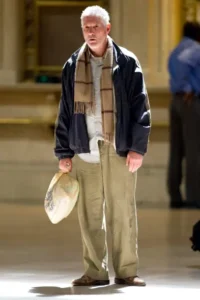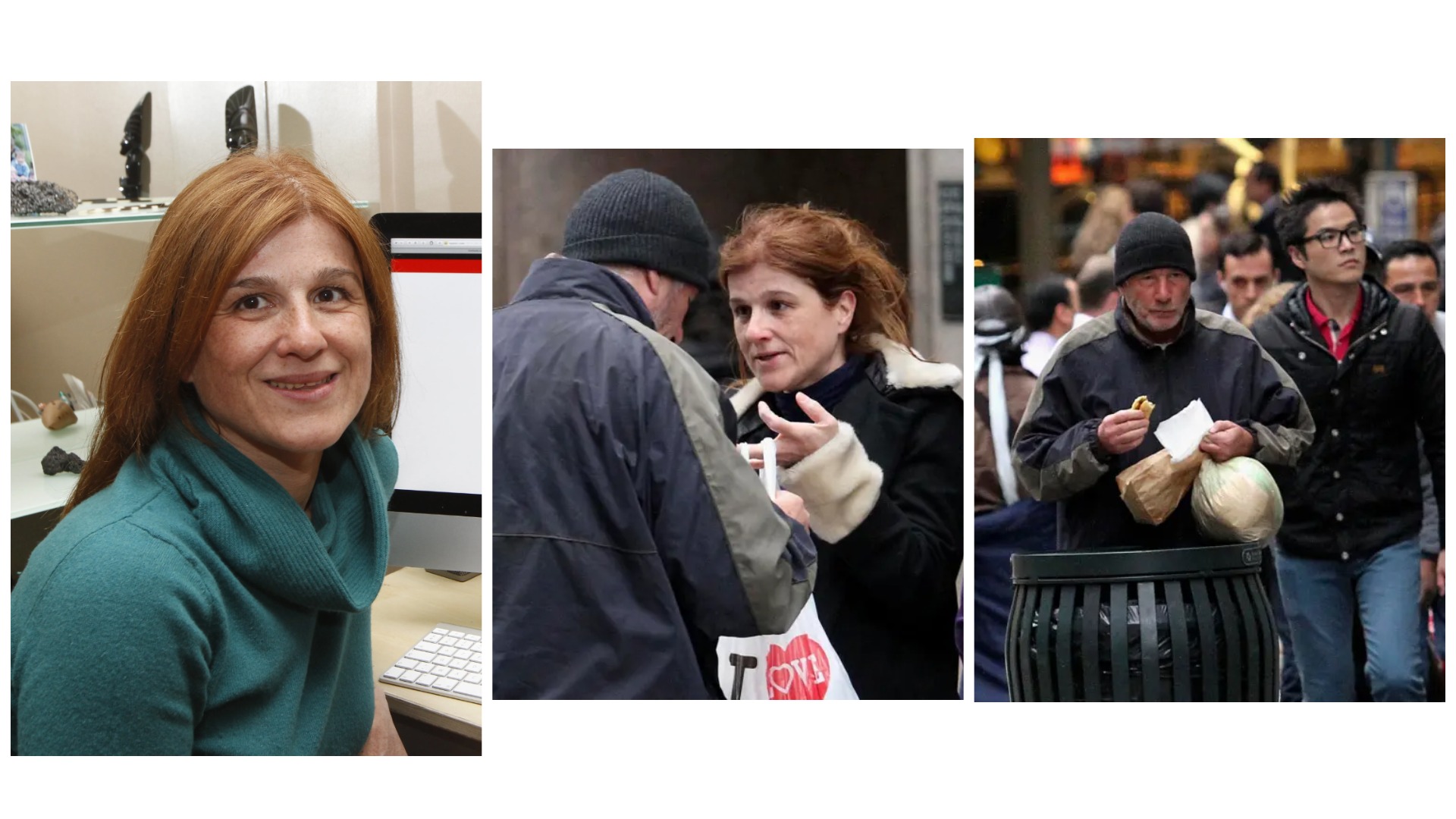She was on vacation from Paris, the kind of four-day whirl that squeezes New York into a postcard: Little Italy for lunch, Bryant Park for photos, Times Square for neon. (She would later say she’d been carrying leftovers because no one could finish the big pie.)
When they stepped out near Grand Central, the wind made traffic lights shiver and a man’s shoulders shake. He was leaning into a bin, inspecting a crumpled paper boat with the solemn care of a surgeon and the hunger of someone who needed luck. She hesitated. Then she didn’t.

She opened her bag and held it out.
He looked at her—really looked—and asked, “What’s inside?” She tried for English; half the sentence arrived in French. “Pizza… it is fresh, please.” He smiled, grateful in a way that embarrassed them both. He said, “Thank you so much. God bless you.” She nodded and hurried away, cheeks hot, feeling both proud and unbearably small in a city that had just reminded her how easy it is to walk past people. (She would later tell reporters almost exactly those words.)
Her husband teased that she’d fed a stranger better than she fed him. Her teenage son rolled his eyes, then snuck another slice from the box. They laughed in the hotel elevator. Still, that face stayed with her—the careful way he cradled the bag as if it might fly off if he breathed too hard.
The next morning they did museums; the day after, a museum of a different sort: the lobby newsstand. The concierge recognized them and slid a tabloid across the counter like a magician completing a trick. There it was: the same man, the same moment, captured from across the street. But the headline wasn’t about homelessness. It was about Hollywood. She blinked at the caption. Richard Gere.
Confusion hit first, then a peculiar guilt—as if kindness given to the wrong person somehow counted less. But the article spelled it out: Gere, 64, had been filming Time Out of Mind, a drama about a man living on the streets of New York, and the French tourist, Karine Valnais Gombeau (sometimes reported as Karine Gombeau-Valnais), had wandered straight into the scene.
Reporters found her; microphones followed. She said she didn’t recognize him. She said she only saw a person who looked hungry. She said, in a half-laughing, half-dazed voice, “I gave my doggy bag to a homeless man… and the homeless is Richard Gere.”

Across town, New Yorkers talked about the photo—how perfectly he blended in, how a movie star could stand in daylight and be invisible if he wore the right jacket and the city kept moving. Vanity Fair even noted that hidden cameras had filmed him rummaging in a trash can for a hamburger, and that a passerby (her) had offered food without knowing it was part of a scene.
Other outlets filled in the edges: she’d just come from a pizzeria, the cap pulled low over the man’s ears, the exchange brief and gentle, the discovery coming two days later with a shock that felt like a dream.
Gere, for his part, had been trying to make the performance disappear into the street—an experiment in humility that critics later said gave the film its ache. He even panhandled while shooting, claiming he went unrecognized and earned about $1.50—an anecdote reviewers repeated to underline how easily we fail to see the people in front of us.
But strip away the headlines, and what remains is a quieter story. A woman saw a man who looked hungry. She offered what she had. He accepted with grace. And then the world—always hungry for irony—decided the moment was more potent because the man was famous.

She wrestled with that. On one hand, the recognition made her simple act global, turning a private kindness into an international headline. On the other, she wished the same attention would land on the many who aren’t famous, the many who never see their names in print. She told friends back home that New York had shown her both kinds of invisibility: the invisibility of people we rush past, and the invisibility we grant to kindness unless a celebrity reflects it back to us.
The photo traveled: morning shows, blogs, think pieces, a thousand captions. Some readers mocked the naiveté; others wept in the comments. A few said it was staged—which misunderstood both filmmaking and the fact that productions can’t choreograph strangers with that kind of authenticity. (Articles made clear she had no idea she was on a set.)
Meanwhile, the city kept moving the way it always does. The trash was collected; the cap and jacket went back to wardrobe racks; the editing bays hummed; and a film about homelessness reached theaters the next year, asking audiences to sit in discomfort long enough to recognize a human being.

If there’s a twist, it isn’t that a movie star accepted pizza. It’s that a stranger gave it without asking for anything in return—and then learned, via a headline, that the person she dignified already belonged to a world that rarely goes hungry. The real punchline is bittersweet: the act doesn’t count less because the receiver was famous. If anything, it should count twice—once for him, and once for all the people we’ll meet tomorrow who won’t come with credits.
Ask her what she remembers most, and it isn’t the newspaper. It’s the look on his face when she said, “Please… take.” The way gratitude, even borrowed for a role, warms the hands that hold a paper bag. The way a city made of stone can feel, for one quiet second, like a kitchen table.
And the moral, printed nowhere but visible everywhere, is this: The story went viral because the man was Richard Gere. But the moment mattered because he could have been anyone.
Conclusion: A gentle gesture collided with celebrity and the internet applauded the coincidence. But beneath the clickbait is the truth New York whispered to a tourist with a warm bag of pizza: see first, label later. The fame was the hook. The humanity is the headline.
Sources
ABC News — “French Tourist Who Gave Food to ‘Hobo’ Richard Gere: ‘I Don’t Believe This’” (Apr 28, 2014). https://abcnews.go.com/blogs/entertainment/2014/04/french-tourist-who-gave-food-to-hobo-richard-gere-i-dont-believe-this (ABC News)
New York Post — “French do-gooder stunned ‘Gere’ was homeless man she helped” (Apr 27, 2014). https://nypost.com/2014/04/27/french-do-gooder-stunned-gere-was-homeless-man-she-helped/ (Нью-Йорк Пост)
New York Post — “Richard Gere fools New Yorkers as homeless man” (Apr 24, 2014). https://nypost.com/2014/04/24/richard-gere-fools-new-yorkers-as-homeless-man/ (Нью-Йорк Пост)
Sky News — “Richard Gere Mistaken For Tramp By Tourist” (Apr 28, 2014). https://news.sky.com/story/richard-gere-mistaken-for-tramp-by-tourist-10407894 (Sky News)
RFI — “French tourist gives ‘homeless’ Richard Gere cold pizza” (Apr 28, 2014). https://www.rfi.fr/en/americas/20140428-french-tourist-gives-homeless-richard-gere-cold-pizza (rfi.fr)
Vanity Fair — “These New Yorkers Mistook Richard Gere for a Homeless Man” (Apr 24, 2014). https://www.vanityfair.com/hollywood/2014/04/richard-gere-homeless-man (Vanity Fair)
TIME (Review) — “Time Out of Mind Heads Below the Poverty Line” (Sep 10, 2015). https://time.com/4029011/time-out-of-mind-heads-below-the-poverty-line/ (TIME)








